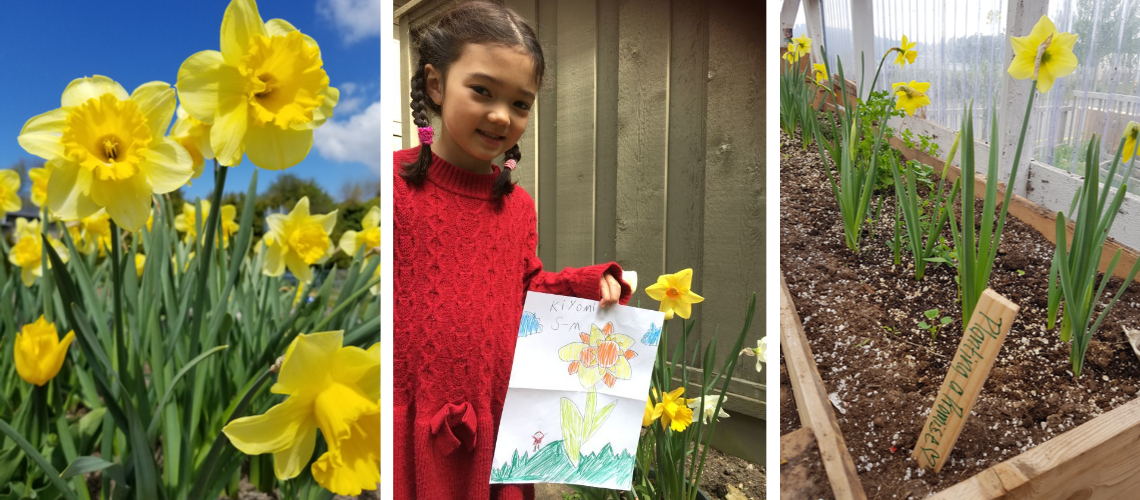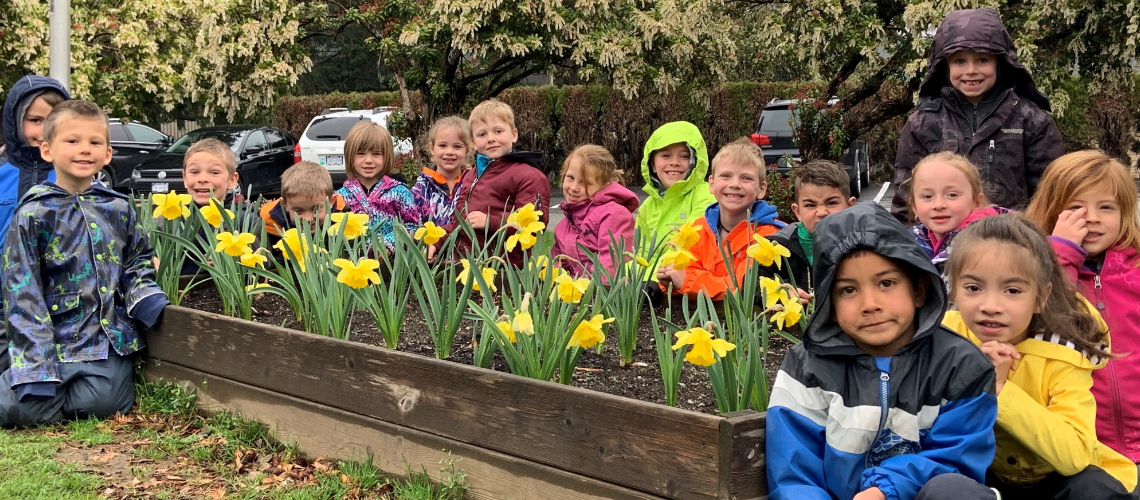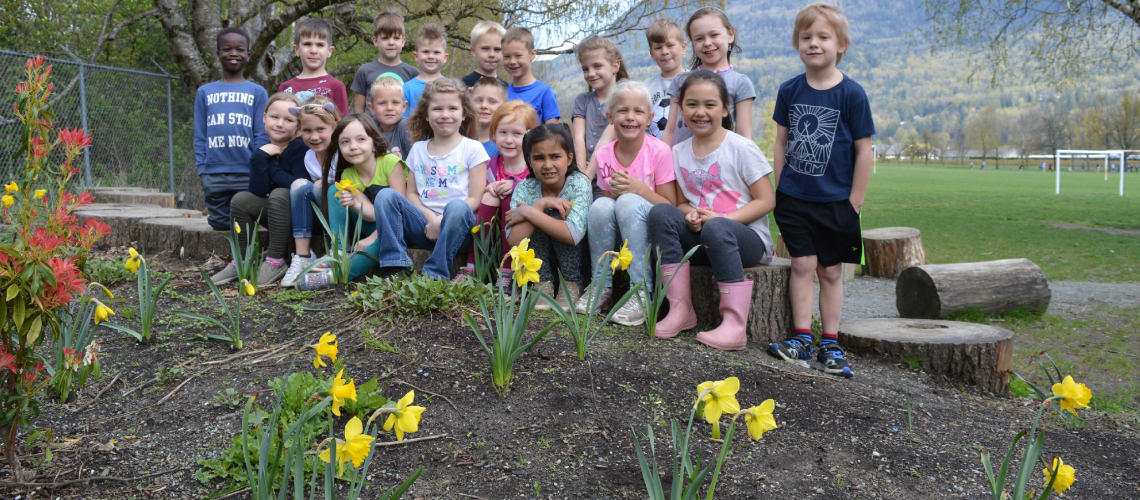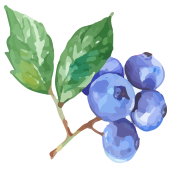Connecting Students to Agriculture
We created Planting a Promise to give teachers and their students a gardening experience and to offer them a hands-on way of exploring the life cycle of a plant and what it needs to grow. Planting a Promise lets teachers take the classroom outdoors, so students can connect positively with nature and learn science through observation. When those cheerful, yellow daffodil blooms greet students in the spring, it gives them a sense of pride in contributing to their school and community.
How Does Planting a Promise Work?
Teachers can register for the Planting a Promise program by emailing help@aitc.ca in early September.
In mid-September, teachers enrolled in Planting a Promise can pick up large daffodil bulbs, provided by BC Agriculture in the Classroom Foundation (BCAITC), from their local garden centres for use with the activities found in the Planting a Promise Handbook. We provide 35 bulbs per classroom.
Choose a bright, foot-traffic-free area of the school for your daffodil garden. If your school and/or district has policies concerning planting in the schoolyard, check with your principal first for permission.
Get Ready for Planting — Here’s What You’ll Need:
- Pictures of daffodils (pages 24-29 of your Planting a Promise Handbook).
- A trowel or spade for each student or group of students, placed in a bucket for easy access.
- Soil (Are you a Spuds and Tubs teacher? Recycle the soil from your potato harvest to improve the soil for your daffodil garden.).
- A bucket or watering can for watering.
- Popsicle sticks with student names on them, or a map of the planting area (optional ideas)
With your help, students can plant their bulbs directly in the ground in the fall. During the winter, if the ground is not too frozen, students can lift some bulbs to observe this stage of their life cycle. In the early spring, as the bulbs begin to sprout, students can observe and track the growth of their daffodils. Finally, when the warm spring days arrive, students are rewarded for their hard work with beautiful yellow flowers. In June, after the flowers bloom, the daffodils enter their dormant stage and prepare to start the cycle all over again.
Planting a Promise in Action
A grade 2/3 class at Upper Sumas Elementary applied science and poetry lessons to the fall planting of daffodils in this following video.
Sign Us Up!
Planting a Promise is a free program available to all K-12 public, independent, and First Nations schools in BC.
Registration for your K-12 classroom begins at the beginning of each school year. For new teachers to this program apply using this form. For teachers returning to the program again apply through your School Login only. Please contact the Program Coordinator at help@aitc.ca if you have any questions. After you express interest in participating, a notification will be sent when a spot becomes available. Remember, the sooner you sign up, the more chance you have at Planting a Promise.

A Crop of Resources!
We have a number of classroom resources to enhance your Planting a Promise teaching opportunity. All of our resources are available as downloads or can be ordered from us.
Our Planting a Promise Handbook contains lessons and activities exploring Big Ideas, Curriculum Competencies, and Content for primary and early intermediate grades in Science, with additional connections for English Language Arts and Arts Education.
Our Planting a Promise PowerPoint presentation for middle-grade students provides a visual tour that illustrates What Plants Need to Grow, The Life Cycle of a Daffodil, and The Parts of the Daffodil.
Our Celebrating Liberation with a Promise Handbook provides information and tips for tulips and daffodils.
Our Planting Intergenerational Promises Handbook provides information on how to use tulips and daffodils to connect students and seniors.
Here are a few more general resources to bring the garden into your classroom and supplement your lessons on the characteristics and life cycle of a plant:
Alfalfabet A to Z: The Wonderful Words from Agriculture (book)
Make A Payment
Partners Make It Possible — Thank You!
Thank you to all of our partners for their help in creating and offering Planting a Promise to BC schools. Together, we can continue to offer this program and share the magic and science of growing spring bulbs with even more BC students.
Program Partners
Alpine Garden Club of British Columbia
New Westminster Horticultural Society
Peace Arch Hospital Foundation
Supporting Nurseries:
Buckerfields — Abbotsford, Duncan, Nanaimo, Parksville, Saanich, Salmon Arm, W. Kelowna
Dykhof Nurseries & Florist — North Vancouver, West Vancouver
GardenWorks — Burnaby/Lougheed, Coquitlam, Courtenay, Mandeville
Hunters Garden Centre — Surrey, Vancouver
Join Us!
To find out how you or your business can support this exciting program, contact BC Agriculture in the Classroom Foundation or check out our Partnership Opportunities.

Teachers and Parents Ask the Best Questions
The life cycle of spring-flowering bulbs, like daffodils, starts in the fall and ends when the bulb goes dormant (living but not actively growing) in the summer. The best time to plant is when the soil is approximately 10° - 13°C. Bulbs require a period of low temperature dormancy in the fall and winter for the bulb to flower in spring. Late October is typically a good time for planting.
Daffodil flowers bloom in early spring (March - April).
No. You only need to water immediately after planting the bulbs.
Cut or pinch off the flower top just below where it looks swollen (refer to your Planting a Promise Handbook for detailed instructions). This will help the bulb retain energy for a new bloom the following spring.




